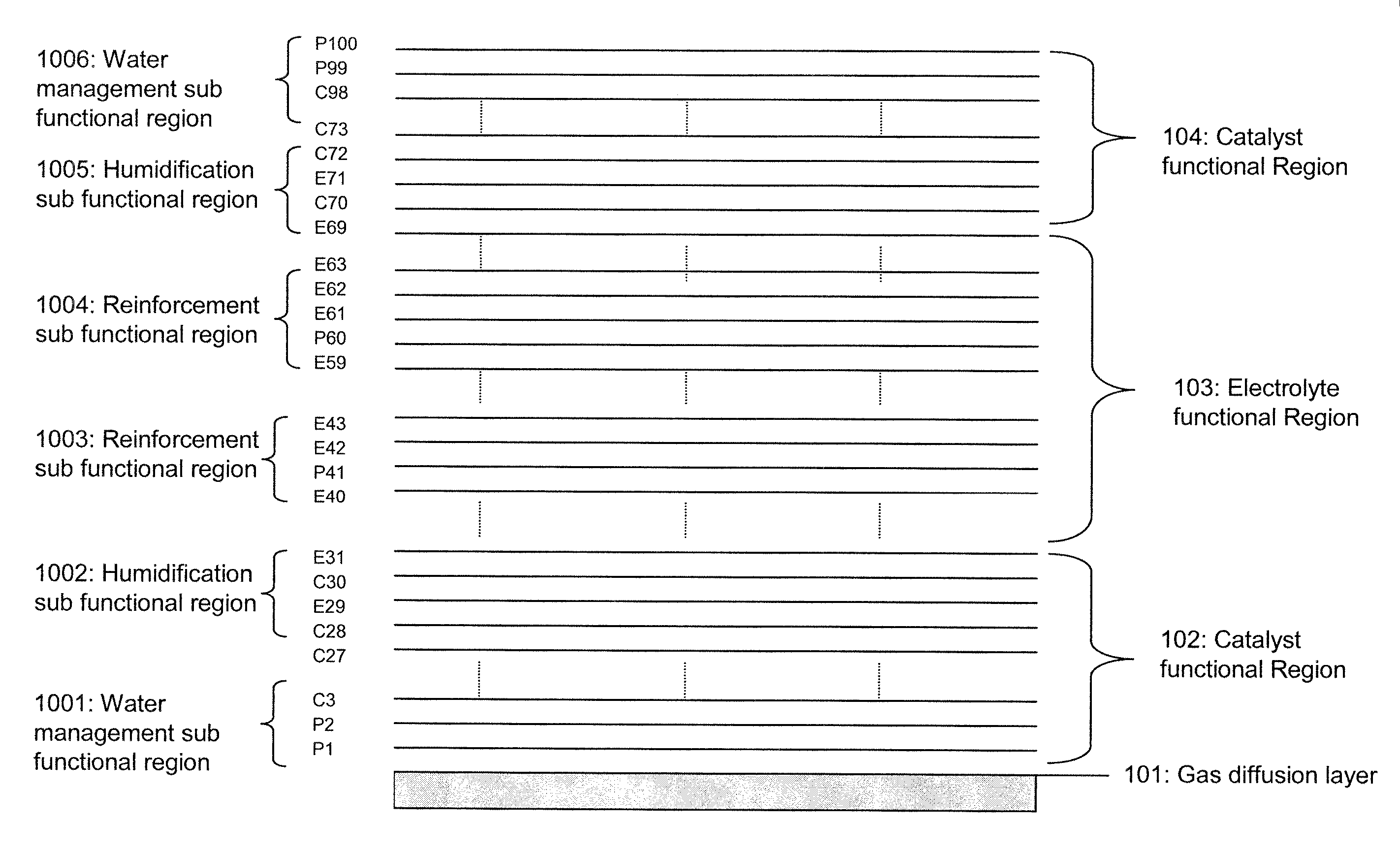Novel membrane electrode assembly and its manufacturing process
a technology of membrane electrodes and manufacturing processes, applied in the manufacture of final products, conductive materials, synthetic resin layered products, etc., can solve the problems of high temperature, damage to membranes, and fine pores in catalyst layers that could be crushed, so as to reduce electric resistance, proton resistance and fuel crossover, the effect of increasing mechanical strength
- Summary
- Abstract
- Description
- Claims
- Application Information
AI Technical Summary
Benefits of technology
Problems solved by technology
Method used
Image
Examples
example 1
[0086] The solution for the polymer layer is atomized with an ultrasonic nozzle at a frequency of 120 KHz and sprayed at a flow rate of 0.5 ml / minute to a heated carbon fiber paper with a surface temperature of 150° C. The droplets dried immediately and multiple coatings are applied, until the dried polymer layers reach 0.4 mg / cm2. The polymer layer coated carbon fiber paper is placed in an oven with a temperature of 370° C. for 20 minutes. It is further placed on a hot plate and heated to 140 C. Then electrolyte solution 1 is atomized and sprayed to the polymer layer coated carbon fiber paper until 0.1 mg / cm2 of electrolyte is coated. Multiple catalyst layers are further sprayed to the carbon fiber paper until a Pt loading of 0.2 mg / cm2 in the new catalyst layers is reached. Multiple electrolyte layers of electrolyte solution 1 are further coated until 5 mg / cm2 of new electrolyte is coated. Multiple catalyst layers are further coated until additional 0.4 mg / cm2 of Pt loading is rea...
example 2
[0087] A 3 micron thick porous PTFE film is placed on a carbon fiber paper, catalyst layers are ultrasonically deposited to the porous PTFE film until the Pt loading of 0.4 mg / cm2 is reached in the first catalyst functional region. Electrolyte layers of electrolyte solution 1 are further ultrasonically deposited to the catalyst functional region until the loading of electrolyte reaches 4 mg / cm2. Catalyst layers are further ultrasonically deposited to the electrolyte functional region until the Pt loading reaches 0.01 mg / cm2. Electrolyte layers then are further deposited until the total electrolyte loading reaches 5 mg / cm2. Finally, catalyst layers for the second catalyst functional region are ultrasonically deposited to the electrolyte functional region until the Pt loading for the second catalyst functional region reaches 0.4 mg / cm2. The MEA then is further heat treated in an oven at 150° C. for 10 minutes. During the entire coating process, the ultrasonic nozzle's frequency is set...
example 3
[0088] A piece of carbon fiber paper is placed on a heated hot plate. The solution for the catalyst layers is atomized and sprayed to the heated carbon fiber paper. The droplets dried immediately and multiple coatings are applied, until the Pt loading of the first catalyst functional region reaches 0.2 mg / cm2. Then the electrolyte layers of solution 1 are atomized and sprayed to the heated carbon fiber paper until the electrolyte functional region reaches 3 mg / cm2 of electrolyte loading. Multiple catalyst layers are further sprayed to the electrolyte layers until the second catalyst region reaches 0.4 mg / cm2 of Pt loading. The MEA is further cut into multiple single cell size MEA (3.4 cm*10 cm) and a smaller single cell size carbon fiber paper (3 cm*9.6 cm) is placed in the middle of the single cell MEA to be further used to assemble fuel cell stacks. The 0.2 mg / cm2 pt loading catalyst functional region can be used as the anode catalyst layers. During the entire coating process, the...
PUM
| Property | Measurement | Unit |
|---|---|---|
| Fraction | aaaaa | aaaaa |
| Fraction | aaaaa | aaaaa |
| Fraction | aaaaa | aaaaa |
Abstract
Description
Claims
Application Information
 Login to View More
Login to View More - R&D
- Intellectual Property
- Life Sciences
- Materials
- Tech Scout
- Unparalleled Data Quality
- Higher Quality Content
- 60% Fewer Hallucinations
Browse by: Latest US Patents, China's latest patents, Technical Efficacy Thesaurus, Application Domain, Technology Topic, Popular Technical Reports.
© 2025 PatSnap. All rights reserved.Legal|Privacy policy|Modern Slavery Act Transparency Statement|Sitemap|About US| Contact US: help@patsnap.com



